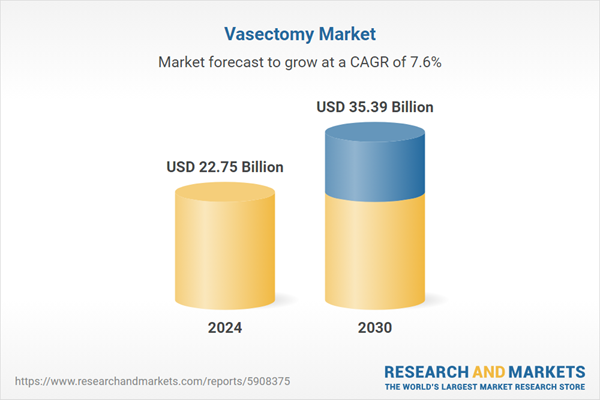Speak directly to the analyst to clarify any post sales queries you may have.
10% Free customizationThis report comes with 10% free customization, enabling you to add data that meets your specific business needs.
Key Market Drivers
Rising Awareness About Male Contraception and Family Planning
The increasing awareness of male contraception and family planning is one of the most significant drivers of the global vasectomy market. Globally, 966 million women of reproductive age are utilizing some form of contraception. Among the 1.9 billion women aged 15 to 49, approximately 874 million rely on modern contraceptive methods, while 92 million use traditional methods. These figures highlight the substantial market penetration of modern contraceptive solutions and the continued demand for both contemporary and conventional birth control options.This shift is fueled by government initiatives, changing societal norms, education programs, and advocacy efforts, all of which contribute to a higher adoption rate of vasectomy as a preferred method of permanent birth control. Governments, international organizations (such as WHO and UNFPA), and NGOs actively promote vasectomy as a safe, effective, and low-cost family planning solution. In many countries, free or heavily subsidized vasectomy procedures are offered as part of public healthcare programs, increasing accessibility for lower-income populations. Some governments provide financial incentives or additional healthcare benefits to men opting for vasectomy, driving adoption rates.
Traditionally, contraception has been considered a woman’s responsibility. However, modern awareness programs emphasize that men should also take an active role in birth control. As societies progress toward gender equality, more men are willing to undergo vasectomy to share the responsibility of family planning, reducing the burden on women. As more men become proactive in reproductive health decisions, demand for vasectomy procedures rises, particularly in urban and educated populations. More healthcare professionals, urologists, and family planning counselors are recommending vasectomy as a safe and effective alternative to female sterilization.
Historically, misconceptions about vasectomy (such as loss of sexual function or masculinity) have deterred men from opting for the procedure. Educational initiatives are correcting these myths, leading to increased confidence in the procedure. A better-informed population results in greater acceptance of vasectomy, increasing patient willingness to undergo the procedure and expanding the market. Companies and local organizations are integrating vasectomy awareness into employee wellness programs and community healthcare initiatives. The expansion of digital health platforms, social media, and online healthcare providers makes educational content about vasectomy more widely available. This drives higher procedural uptake as men gain easier access to reliable information and healthcare services.
Key Market Challenges
Cultural Stigma and Misconceptions
One of the foremost challenges in the global vasectomy market is the persistence of cultural stigma and misconceptions surrounding the procedure. In some societies, vasectomy is still associated with emasculation or concerns about sexual performance. Misunderstandings about the procedure's reversibility or its impact on masculinity deter potential candidates. Addressing these misconceptions through education and awareness campaigns is crucial to overcoming this challenge.Key Market Trends
Minimally Invasive Techniques
While minimally invasive techniques, such as non-scalpel vasectomy, have already gained traction, ongoing research and innovation are expected to further refine these approaches. Continued improvements in surgical techniques will lead to even shorter recovery times, reduced discomfort, and fewer complications, making vasectomy an even more attractive choice for potential candidates.Key Market Players
- Pfizer Inc
- Bristol Myers Squibb SA
- Teva Pharmaceuticals USA Inc
- Upsher-Smith Laboratories Inc
- SMITHFIELD BIOSCIENCE
- Opocrin SPA
- Bioiberica SA
- GSK PLC
- Johnson & Johnson Consumer Inc
- Fresenius SE & Co KGaA
Report Scope:
In this report, the Global Vasectomy Market has been segmented into the following categories, in addition to the industry trends which have also been detailed below:Vasectomy Market, By Type:
- Conventional
- Minimally Invasive
- No-Scalpel
Vasectomy Market, By Patient:
- Animal
- Human
Vasectomy Market, By End-User:
- Hospitals & Clinics
- Ambulatory Care Centers
- Others
Vasectomy Market, By Region:
- North America
- United States
- Canada
- Mexico
- Europe
- Germany
- United Kingdom
- France
- Italy
- Spain
- Asia-Pacific
- China
- Japan
- India
- Australia
- South Korea
- South America
- Brazil
- Argentina
- Colombia
- Middle East & Africa
- South Africa
- Saudi Arabia
- UAE
- Kuwait
Competitive Landscape
Company Profiles: Detailed analysis of the major companies present in the Global Vasectomy Market.Available Customizations:
With the given market data, the publisher offers customizations according to a company's specific needs. The following customization options are available for the report.Company Information
- Detailed analysis and profiling of additional market players (up to five).
This product will be delivered within 1-3 business days.
Table of Contents
Companies Mentioned
- Pfizer Inc
- Bristol Myers Squibb SA
- Teva Pharmaceuticals USA Inc
- Upsher-Smith Laboratories Inc
- SMITHFIELD BIOSCIENCE
- Opocrin SPA
- Bioiberica SA
- GSK PLC
- Johnson & Johnson Consumer Inc
- Fresenius SE & Co KGaA
Table Information
| Report Attribute | Details |
|---|---|
| No. of Pages | 185 |
| Published | February 2025 |
| Forecast Period | 2024 - 2030 |
| Estimated Market Value ( USD | $ 22.75 Billion |
| Forecasted Market Value ( USD | $ 35.39 Billion |
| Compound Annual Growth Rate | 7.6% |
| Regions Covered | Global |
| No. of Companies Mentioned | 10 |









